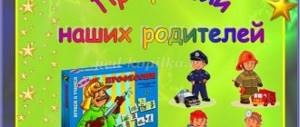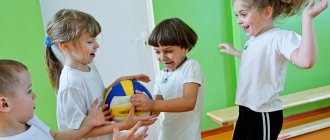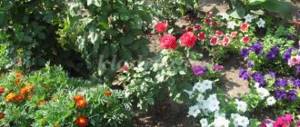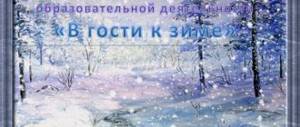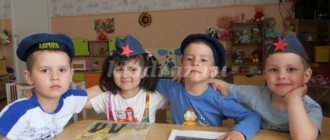Creative report from the teacher on the work done for the 2018-2019 academic year
municipal budgetary preschool educational institution of Shakhty, Rostov region “Kindergarten No. 70”
Creative report
about the work done
for the 2018–2019 academic
year in the
“Fantasers” secondary group.
teacher of MBDOU No. 70 in Shakhty
Vlasenko Olga Mikhailovna
2018-2020 academic year
Content:
1. Information and statistical section 2. Pedagogical activities 3. Achievements of all participants in the educational process 4. Work with parents 5. Plans for the next school year 6. Conclusions
Brief description of the middle group “Dreamers”:
Total number of children: At the beginning of the school year – 21 children, at the end of the year – 21 children, of which: – 10 girls;
- 11 boys. The average age of children is 5 years. The average attendance in the group for the 2018-2019 academic year is 71%. The incidence of illness in children is mainly associated with seasonal weather conditions, such as acute respiratory infections and acute respiratory viral infections. All children developed according to their age; many showed positive dynamics towards further success. Pedagogical activity.
The activities of the group were carried out in accordance with the annual work plan of MBDOU No. 70 of the city of Shakhty for the reporting period, the main general educational program of preschool education, which meets the requirements of the Federal State Educational Standard, “FROM BIRTH TO SCHOOL” - Model general educational program of preschool education / Ed.
N. E. Veraksy, T. S. Komarova, M. A. Vasilyeva. — M.: MOSAIKA SYNTHESIS, 2020. The organization of the educational process was based on a pedagogically sound choice of program, the main goals of which are: — creation of favorable conditions for a child to fully enjoy preschool childhood, — formation of the foundations of basic personal culture, — comprehensive development of mental and physical qualities in accordance with age and individual characteristics, - preparation for life in modern society, - formation of prerequisites for educational activities, - ensuring the safety of life of a preschooler. According to the program, the group’s teachers were given the following tasks: - creating optimal conditions for the development of each child in the group; — ensuring emotional well-being in the group for all students; — application of modern health-saving methods of development and training; — maximum use of all available methods in order to increase the effectiveness of the educational process; —
variable use of educational material;
— providing a favorable environment for the development of the creative potential of each child; - use of various types of children's activities; — strengthening connections between all participants in the educational process for the benefit of children; ECD was carried out in accordance with the main educational program of the preschool educational institution, according to the calendar and thematic plan of the group and the approved schedule of direct educational activities. When organizing the educational process, the principles of integration of educational areas were taken into account in accordance with the age capabilities and characteristics of children. When organizing the activities of children, I tried to develop in each child the desire to show initiative and independence, to find a reasonable and worthy way out of various situations. The set goals were achieved in the process of implementing various types of activities: gaming, communicative, labor, cognitive-research, productive, perception of fiction and folklore, musical and motor. My activities as a teacher included solving educational problems in the joint activities of adults and children, independent activities of pupils, not only within the framework of direct educational activities, but also during regime moments. When carrying out organized activities, traditional methods of work were used, such as observation, conversations, comparison, monitoring, individual work, and non-traditional methods - non-traditional techniques in drawing, experimentation, the project method. The design method made it possible to change the style of working with children ,
increase children's independence, activity, curiosity, involve parents and other family members in the educational process of a preschool institution.
Achievements of all participants in the educational process
The use of innovative technologies in the upbringing and teaching of children influenced the dynamics of improving the quality of mastering program material, and also gave stable results based on the results of children mastering the preschool program.
Several forms of diagnostics were used: - observation of the child; - daily conversations; — analysis of children's activity products; — organization of special gaming activities; - criterion-oriented methods of non-test type. Summary table of monitoring the achievement of the planned results of mastering the educational program by children of the “Fantasers” secondary group for the 2018-2019 academic year.
Annual report of teachers on the work done. material (senior group)
Annual report of teachers on the work done.
Report on the work done for the 2019-2020 academic year by teachers of senior group “A” “Fairy Tale” Svetlana Vladimirovna Ukolova, Elena Sergeevna Chubarova.
General characteristics of the group
The senior group has two teachers. The roster of the group consisted of 27 children, of which 12 were girls and 15 were boys.
The age of children is from 5 to 6 years. Partnership relationships and joint activities of children predominate. Conflicts between children, if they arise, are quickly and productively resolved.
Over the course of the year, children developed according to their age, studied program materials and showed positive dynamics in all areas of development.
The educational process is focused on the implementation of the work program developed on the basis of the Educational Program of Preschool Education of MBDOU Kindergarten No. 15.
The work of the group was carried out based on the main annual tasks and in accordance with the annual work plan. During the year, the daily routine and sanitary and hygienic requirements for the stay of children in the MBDOU were observed.
Direct educational activities were systematically carried out with the children. During the study, both traditional observations, conversations, comparisons and non-traditional methods of work were used - finger exercises, breathing exercises, eye exercises. A health card file has been created for working with children.
The set goals were achieved in the process of implementing various types of activities: gaming, communicative, labor, cognitive-research, productive, musical, artistic and fiction. All types of activities represent the main directions of children’s development: physical, cognitive-speech, artistic and aesthetic.
In educational, educational and everyday play activities, children gained knowledge about human labor, seasonal changes in nature, the conditions necessary for plant growth, domestic and wild animals, migratory and wintering birds. Many conversations were held about the phenomena of social life, about the native country, about family members and their care for each other and about its significance.
Children are able to distinguish: in case of careless handling of fire or electrical appliances, a fire may occur; rules for hanging out with strangers; traffic rules and behavior on the street; traffic lights; special transport; rules of behavior in public transport.
All the students in the group love to dramatize excerpts from familiar fairy tales using tabletop theater figures. Not all children pronounce sounds clearly and find it difficult to compose stories from personal experience and from pictures. In-depth work on this topic will continue.
Most children are interested in cognitive and research activities in design and mathematics. They know how to group objects by shape, color, size and select one object from the group. Find objects of the same shape in your surroundings. Identify geometric shapes. They understand the words: in front, behind, above, below, above, below. Not all children solve the simplest arithmetic and logical problems with scores within 10.
Assimilation of program material causes difficulties for some preschoolers. With these children we continue to solve the problem in the development of the cognitive sphere using individual work and didactic games.
In productive activities, a lot of work has been done to cultivate emotional responsiveness when perceiving illustrations and works of folk arts and crafts. In their works, children use various color schemes to create expressive images and intricate plots. Use pencils and paints correctly. We got acquainted with the decorative painting of Gzhelskaya, Dymkovskaya and others. The children learned to sculpt characters from fairy tales (a bear, a fox and a bunny). We learned to sculpt from life (vegetables, fruits, dishes, toys). And also sculpt dishes from a whole piece of plasticine. Children's skills in working with scissors have been improved. Children can cut paper into short and long pieces, and cut circles from squares.
Work on familiarization with fiction was carried out very successfully throughout the year.
The group provides conditions and systematic work is carried out for the moral education of children. Children learn to play together and help each other in times of difficulty, politely greet each other, say goodbye, thank them for their help, master knowledge and skills - adequately navigate the accessible social environment, using the skills of social partnership for personal harmonious development in society. Complexity in the group is created by the behavior of hyperactive children, we are constantly working and in the future we will pay special attention and teach children to live together, help each other, use toys, books together and follow the rules of conduct in kindergarten.
During the year, the group regularly carried out educational, physical education and health activities. Hardening and preventive measures were carried out during walks and in groups. Morning exercises, walks with outdoor games, invigorating and breathing exercises, and physical exercises were carried out every day.
Children take care of their appearance, wash their hands before eating and after using the toilet, eat food nicely and correctly, although there are exceptions: but they try to match the level of other children. Labor education at the end of the school year is at a fairly high level. In the group room, children know how to maintain order and clean their play areas. The supposed reason for this phenomenon is the independence and interested activity of children.
The training area contains material for the sections of the program. On the development of speech, there are colorful illustrations on the topics “Seasons”, “Vegetables and Fruits”, “Wild and Domestic Animals”, collections of poems and stories, didactic games, plot pictures for teaching storytelling, etc.
In the period from September to March, the developmental environment in the group was updated and replenished: stands were made on road safety rules, didactic games (moving folders with information for parents, handouts), a corner on patriotic education was designed, and a card index on experimentation was created.
Our group is equipped with play activities. Thematic role-playing games are presented: “Hospital”, “Shop”, “Hairdresser”, “Fishing”. Children of this age group clearly show interest in play. The game continues to be the main form of organization of their lives. Children participate in a variety of games throughout the day. Some of them are organized and used as a means of solving certain problems. For example, games with ready-made content and rules are used to develop attention, speech, the ability to compare, and act according to a basic algorithm. Children are experiencing an awakening interest in rules of behavior.
There are various building materials, educational mosaics and construction sets, which children often use as substitute objects.
There is a music corner with musical and noise instruments and a theater corner.
In the group, the necessary materials for artistic creativity of preschoolers (pencils, paints, brushes, plasticine, modeling boards, stacks, scissors, illustrative material, etc.) are freely available to children. Children's creative works are exhibited on the "Creativity Wall".
To develop elementary mathematical concepts in children, there is material for teaching children to count, develop ideas about the size and shape of objects, numbers, clocks, and educational games.
For the speech development of preschoolers, there is a book corner in accordance with the age of the children, a selection of thematic illustrations.
Our group also has a duty corner.
Interaction with parents of students
Informing parents about the progress of the educational process: individual consultations, parent meetings, design of information stands, organization of exhibitions of children's creativity, inviting parents to children's parties. The result of interaction between teachers and parents is: increased activity of parents in the life of the group and kindergarten; exhibitions of joint crafts and drawings of children and parents; participation in holidays and leisure activities.
Brief description of activities with children throughout the year
During the year, the group held events with children, which were prepared by teachers together with the music director, and with a physical education worker. Between September and May, children of the older group took part with great interest in thematic holidays: Autumn Festival, Mother's Day, New Year's holiday, the Winter Crystal festival, International Women's Day.
We took part in the following competitions: “Doutessa”, “Kindness is Walking on the Earth”, Traffic Rules, New Year, “Extension”.
Took part in exhibitions.
Brief description of events with teachers:
Master classes were held on the topic “Experimentation” (E.S. Chubarova), “Walk in the spring” (S.V. Ukolova).
Brief description of activities with parents:
Conducting parent meetings, individual conversations, consultations, entertainment.
Took part in exhibitions.
During the academic year we took part in:
- took an active part in preschool events.
-participated in pedagogical councils.
— took an active part in online competitions: “Doutessa”, “Prodlenka”.
-attended the method. associations.
- took part in the projects “Hello, Autumn”, “Our Favorite Vegetable Garden”.
- took part in the traffic rules competition, New Year (drawings, CDT).
— increasing the level of pedagogical skills through self-education and exchange of work experience.
-passed
advanced training course under the program “Prevention of coronavirus, influenza and other acute respiratory viral infections in educational institutions”, “Training of teaching staff in first aid skills”.
We are planning for the next academic year:
1. Continue to cultivate creativity, emotionality, and activity in children for their further achievements and success.
2. Continued improvement of the subject-spatial development environment in accordance with the Federal State Educational Standard. Replenish: didactic and handouts for the development of logical thinking; corner of role-playing games; book corner with literature by age.
3. Improving work on interaction with parents;
4. Active participation in preschool events.




